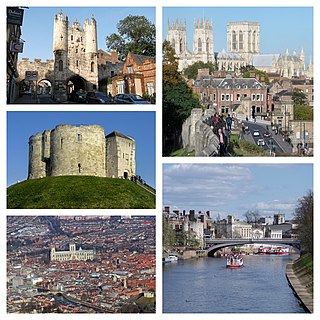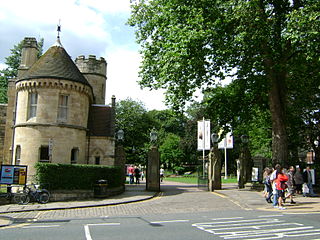
York is a cathedral city in North Yorkshire, England, with Roman origins, sited at the confluence of the rivers Ouse and Foss. It is the county town of Yorkshire. The city has many historic buildings and other structures, such as a minster, castle, and city walls. It is the largest settlement and the administrative centre of the wider City of York district. Through the title of Duke of York, it is the namesake of New York City.

A tourist attraction is a place of interest that tourists visit, typically for its inherent or an exhibited natural or cultural value, historical significance, natural or built beauty, offering leisure and amusement.

York Castle is a fortified complex in the city of York, England. It consists of a sequence of castles, prisons, law courts and other buildings, which were built over the last nine centuries on the south side of the River Foss. The now ruined keep of the medieval Norman castle is commonly referred to as Clifford's Tower. Built originally on the orders of William I to dominate the former Viking city of Jórvík, the castle suffered a tumultuous early history before developing into a major fortification with extensive water defences. After a major explosion in 1684 rendered the remaining military defences uninhabitable, York Castle continued to be used as a gaol and prison until 1929.

The Richard III Experience at Monk Bar was located in Monk Bar, the tallest of the four gatehouses in the historical city walls of York, England. It described the life of Richard III, the last king of the Plantagenet dynasty.

York has, since Roman times, been defended by walls of one form or another. To this day, substantial portions of the walls remain, and York has more miles of intact wall than any other city in England. They are known variously as York City Walls, the Bar Walls and the Roman walls. The walls are generally 13 feet (4m) high and 6 feet (1.8m) wide. They are the longest town walls in England.

The York Archaeological Trust for Excavation and Research Limited (YAT) is an educational charity, established in 1972 in the city of York, England. It carries out archaeological investigations, fieldwork, excavation and research in York, Yorkshire and throughout Britain and beyond. Its staff include specialists in archaeological excavation, historic building analysis and recording, artefact curation, conservation and research, archaeological computing, and illustration and design.

Hertford Castle was built in Norman times beside the River Lea in Hertford, the county town of Hertfordshire, England. Most of the internal buildings of the castle have been demolished. The main surviving section is the Tudor gatehouse, which is a Grade I listed building. Parts of the bailey walls on the east side of the castle also still stand, and are a Grade II* listed building.

The York Museum Gardens are botanic gardens in the centre of York, England, beside the River Ouse. They cover an area of 10 acres (4.0 ha) of the former grounds of St Mary's Abbey, and were created in the 1830s by the Yorkshire Philosophical Society along with the Yorkshire Museum which they contain.

Atomic tourism or nuclear tourism is a recent form of tourism in which visitors learn about the Atomic Age by traveling to significant sites in atomic history such as nuclear test reactors, museums with nuclear weapon artifacts, delivery vehicles, sites where atomic weapons were detonated, and nuclear power plants.

The Jorvik Viking Centre is a museum and visitor attraction in York, England, containing lifelike mannequins and life-size dioramas depicting Viking life in the city. Visitors are taken through the dioramas in small carriages equipped with speakers. It was created by the York Archaeological Trust and opened in 1984. Its name is derived from Jórvík, the Old Norse name for York and the surrounding Viking Kingdom of Yorkshire.

The International Antarctic Centre is a visitor attraction and public science discovery centre in the suburb of Harewood, Christchurch, New Zealand. It is located at Christchurch International Airport, adjacent to the buildings that are the Christchurch base for the Antarctic programmes of the US, New Zealand and Italy.

The York Castle Museum is a museum located in York, North Yorkshire, England, on the site of York Castle, which was originally built by William the Conqueror in 1068. The museum itself was founded by John L. Kirk in 1938, and is housed in prison buildings which were built on the site of the castle in the 18th century, the debtors' prison and the female prison.

York Art Gallery is a public art gallery in York, England, with a collection of paintings from 14th-century to contemporary, prints, watercolours, drawings, and ceramics. It closed for major redevelopment in 2013, reopening in summer of 2015. The building is a Grade II listed building and is managed by York Museums Trust.

Leeds in West Yorkshire, England is a tourist destination.
York and its district, the City of York, has many distinct localities, suburbs and villages.

Tourism in Yorkshire generates more than £9 billion per annum and supporting almost 225,000 jobs. During 2007 recorded 92 million day visitors and 12.8 million that stayed at least one night in the region. By 2015, the value of tourism was in excess of £7 billion. Yorkshire is around 6,000 square miles (16,000 km2) in size. The official tourism body for the region was Welcome to Yorkshire until it became insolvent in 2022. As of December 2023, Local Visitor Economy Partnerships to manage tourism have been announced for Hull and East Yorkshire, York and North Yorkshire, and West Yorkshire.

The Little Museum of Dublin is a local history museum situated at St Stephen's Green, Dublin, Ireland. The museum is located in an 18th-century Georgian townhouse owned by Dublin City Council.

Micklegate is a street in the City of York, England. The name means "Great Street", "gate" coming from the Old Norse gata, or street.





















